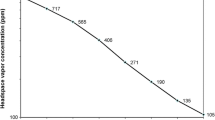Abstract
To clarify the existence of a receptor protein for sensory irritants in trigeminal nerve endings, d- [i.e. (+)] and l- [i.e. (−)] enantiomers of α- and β-pinene as models of nonreactive chemicals were evaluated for their potency in outbred OF1 and NIH/S mice using ASTM E981-84 bioassay. All pinenes possess sensory irritation properties and also induced sedation and signs of anaesthesia but had no pulmonary irritation effects. According to the ratio of RD50 (i.e. concentration which causes a 50% decrease in respiratory rate, f ) and vapour pressure (Po), all pinenes are nonreactive chemicals. For nonreactive chemicals, P° and olive oil-gas partition (LOil) can be used to estimate their potency as sensory irritant. Thus, for enantiomers with identical physicochemical properties, the estimated RD50 values are the same. In addition, although α- and β-pinene do not have identical Po and LOil values, their estimated potencies are quite close. However, the experimental results showed that d-enantiomers of pinenes were the most potent as sensory irritants and a difference in potency also exists between α- and β-pinene. RD50 for d-enantiomers of α- and β-pinene were almost equal, 1053 ppm and 1279 ppm in OF1 strain and 1107 ppm and 1419 ppm in NIH/S strain, respectively. Values differed by a factor of ∼4 to 5 from l-β-pinene for which the RD50 was 4663 ppm in OF1 and 5811 ppm in NIH/S mice. RD50 could not be determined for l-α-pinene; this pinene was almost inactive. d-α-pinene seems to best fit the receptor because its experimental RD50 was one-half of the estimated value while for d-β-pinene those values were equal. On the contrary, l-β-pinene was about 3 to 4␣times less potent than estimated. l-α-pinene was only slightly active although it was estimated to be as potent as d-α-pinene. The remarkable difference in potency between l-enantiometers is most likely due to a structural difference between α- and β-pinene: the more flexible β-pinene can bend to fit into the receptor better than the rigid α-pinene. The results showed that the commonly used physicochemical descriptors cannot fully explain the potency of these chemicals; their three-dimensional structure should also be considered. Because of the stereospecificity of pinenes, a target site for nonreactive sensory irritants is most likely a receptor protein containing a chiral lipophilic pocket.
Similar content being viewed by others
Author information
Authors and Affiliations
Additional information
Received: 3 March 1998 / Accepted: 28 April 1998
Rights and permissions
About this article
Cite this article
Kasanen, JP., Pasanen, AL., Pasanen, P. et al. Stereospecificity of the sensory irritation receptor for nonreactive chemicals illustrated by pinene enantiomers. Arch Toxicol 72, 514–523 (1998). https://doi.org/10.1007/s002040050536
Issue Date:
DOI: https://doi.org/10.1007/s002040050536




